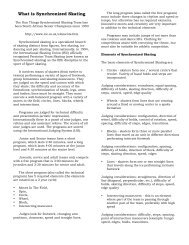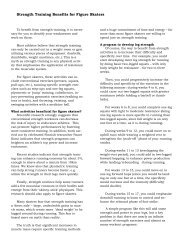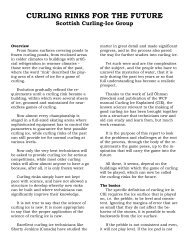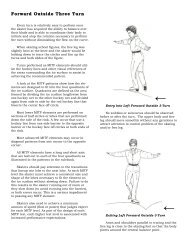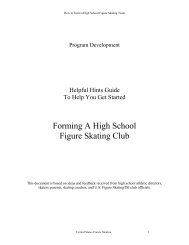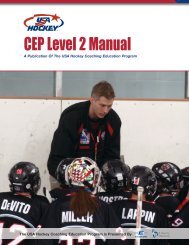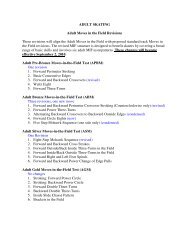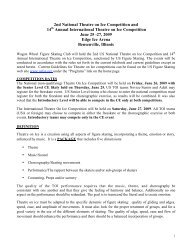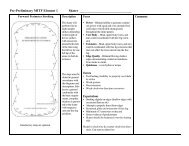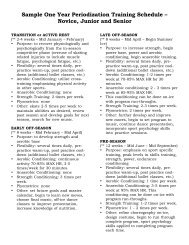CEP Level 3 Manual - Rushmore Hockey Association
CEP Level 3 Manual - Rushmore Hockey Association
CEP Level 3 Manual - Rushmore Hockey Association
Create successful ePaper yourself
Turn your PDF publications into a flip-book with our unique Google optimized e-Paper software.
T A B L E O F C O N T E N T SEven if every player mastered every skill, knowledge orattitude you taught, there is still room for coachingimprovementFor example, all of your players may haveimproved in one or more of the skills included inone of the performance areas of the form, but youmay feel that several of those players did not achieveenough to receive a “yes”. A “no”, however, mayalso seem to be an inappropriate entry. To resolvethis difficulty, it is important for you to consider theamount of player achievement in eachperformance area that you are willing to accept asevidence of effective coaching. Achievement of asignificant and important improvement (orrefinement and/or maintenance of a pre-existinghighly refined ability) on at least 80% of theobjectives included in your season plan is acommon standard for making this determination.Extending that standard to obtain an evaluation ofthe entire team, requires 80% of the playersachieving 80% of the objectives.Initially, you should evaluate your effectivenessin facilitating player competence using the formdescribed above. Self evaluation is usually themost important source of information forimproving coaching actions. Although it is animportant input for making changes, somechanges that are apparent to others are oftenmissed in a self evaluation. There are several waysthat you can obtain additional insight. This willrequire identifying a person who is familiar with yourcoaching actions, the progress of your players, andwhose judgment you respect. This person(s) couldbe an assistant coach, parent, official, leaguesupervisor, other coach or a local hockey expert.One or more players could also rate the status andimprovement of an individual player or the teamrelative to other players in the league. The results ofthis type of evaluation can be very helpful to youbecause it identifies player strength andweaknesses, as perceived by others.For evaluating a player or the team, relative toother players in the league, use the form entitled,“Player Performance Relative to Others”. Forexample, when rating individual players, a simplecheck mark can be entered in the appropriatecolumn for each performance area. When ratingthe entire team, the number of players judged tobe in each column can be entered. The actualnumber or a percentage could be used.Rating of player performance at the end of theseason is not very useful without knowing playerperformance levels at the beginning of the season. Itis the change in the performance levels of theplayers that provides insight as to how effective yourcoaching actions have been. The best way todetermine change in a player’s performance,therefore, is to obtain a rating prior to the period oftime that coaching occurred and another ratingsubsequent to the coaching.Two or more ratings may be difficult to obtain,however, because of the time involved and the busyschedules of your evaluators. A good alternative isto have the evaluator(s) record changes in playerperformance they have observed using a doubleentry system. For example, when using the secondinstrument, if three of your players were perceivedto be in the top 10 percent of their peers at thebeginning of the evaluation period, and four wereelevated to that performance level by the end of theevaluative period, the appropriate ratings would beB3 and E4. The Player Performance Relative ToOthers form is found at the end of this chapter.Using the ResultsIt would be nice to look at your evaluation ofplayer performance and the evaluation(s) of theirperformance by others and see only “yes” or top10% ratings. Such a set of responses, however,would not be very helpful for improving yourcoaching effectiveness. This kind of rating patternwould probably signal the use of a relaxed set ofstandards. Every coach misses the mark ofcoaching perfection in one or more of the fourlisted goal areas and/or with one or more of theplayers on the team. It is these failures that aremost useful in revealing what principles ofcoaching effectiveness are not being met. It isimportant, therefore, to use evaluative standards foryour self-ratings (or for the ratings of others) thatresult in no more than 80% of the responses being“yes” on your evaluation of player performance or inthe top 20% when compared with others. This doesnot mean that you are unable to attain high levels ofcoaching effectiveness. Rather, it provides a meansto determine areas where your effectiveness isrelatively strong or weak.How do you rate as a coach?Checklist of Effective Coaching ActionsThe real benefits of evaluating playerachievement on the objectives of the season ineach of the performance areas listed comes withevaluating the reasons why, “no” or “few” top25% responses are recorded for your players. It isthe answer(s) to the “why”? question that reveals thechanges you can make to improve your coachingeffectiveness. To help you determine the reasonswhy you were not effective in certain playerperformance areas, a “Checklist of EffectiveCoaching Actions” was developed. The checklistprovides a guide for you to use when consideringsome of the characteristics associated with effectivecoaching. For example, if Johnny made insufficientprogress in his puck control skills, you could reviewthe checklist to determine which coaching actionsyou could change in order to get players like Johnnyto be more successful with puck control. As youidentify coaching actions that may have detractedfrom player performance, check the chapterreference and read the information included in thatportion of the manual. Based on the informationcontained in that chapter, alter your subsequentcoaching actions accordingly. The Checklist ForEffective Coaching Actions is found on page 43.Interpreting Unmet ExpectationsThe previous suggestions provide a positiveway to improve your coaching ability. There are,however, ways to interpret a lack of improvedperformance. One often-used excuse is to blamelack of performance on lack of interest. Although itis commonly done, there is seldom justification forclaiming this excuse. Effective youth hockeycoaches significantly alter player skill, knowledge,fitness and attitudes regularly, and even withbelow average talent, rarely finish in the lowerdivision of their league. The most helpful approachyou can use to improve your coaching effectivenessis to assume that when results do not meetexpectations, the solution to the problem will befound in your coaching actions. This may prove tobe the wrong reason, but you must be absolutelysure that you have considered all possibilities forself-improvement prior to accepting other reasonsfor unmet expectations.You must also evaluate the performancestandards that you expect your players to attain. Ifyou determine that poor player performance cannotbe attributed to ineffective coaching actions, it ispossible that the level of expectation you hold foryour players is unrealistic. Remember, motivationis enhanced when players are achievingperformance expectations that are self imposed orcommunicated by the coach. If these expectationsare too high, they can have a negative effect onachievement. There are many valid reasons whythe vast majority of Mites will not perform as wellas Squirts or Bantams. Although it is appropriate tohold high expectations for your players, they mustalso be realistic. A combination of highexpectations that are divided into achievable andsequential performance steps is the creativealternative that is most likely to yield appropriateand effective standards of performance.The allotment of insufficient time to thepractice of the season’s objectives can result inpoor player achievement, even when performanceexpectations and coaching actions areappropriate. Players must have sufficient time toattempt a task, make errors, obtain feedback, refinetheir attempt, and habituate abilities before it isreasonable to expect these abilities to be usedwithin the context of a game. Attempting to covertoo many skills within a limited amount of practicetime is a major cause of delayed achievement. Evenwhen the quality of coaching is excellent in all otherareas, player performance expectations may not bemet simply because the amount of coaching andpractice time was too short.Taking Appropriate ActionsThe reason for conducting an evaluation ofyour coaching effectiveness is to learn what youcan do to improve your contribution to yourplayers. Coaches would all like to receive excellentratings in all categories, but no one attains thatstatus. We all can find ways to improve oureffectiveness. It may be in-season or practiceplanning, implementation of plans, knowledge ofthe game, or even in our ability to evaluateourselves. Regardless of our level of expertise, bysystematically relating high and low levels of player18 | USA <strong>Hockey</strong> Coaching Education Program <strong>Level</strong> 3 <strong>Manual</strong>Role of the Coach | 19



